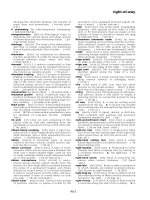Engineering Mechanics - Statics Episode 2 Part 10 ppt
Bạn đang xem bản rút gọn của tài liệu. Xem và tải ngay bản đầy đủ của tài liệu tại đây (538 KB, 40 trang )
Engineering Mechanics - Statics Chapter 7
pp
gg y
sag is h, determine the maximum tension in the chain.
Given:
w 0.5
lb
ft
=
L 60 ft=
h 3 ft=
Solution:
Form Example 7-15
y
F
H
w
cosh
wx
F
H
⎛
⎜
⎝
⎞
⎟
⎠
1−
⎛
⎜
⎝
⎞
⎟
⎠
=
x
y
d
d
sinh
wx
F
H
⎛
⎜
⎝
⎞
⎟
⎠
=
Guess F
H
1
lb=
Given h
F
H
w
cosh
w
F
H
L
2
⎛
⎜
⎝
⎞
⎟
⎠
1−
⎛
⎜
⎝
⎞
⎟
⎠
= F
H
Find F
H
()
= F
H
75.2
lb=
θ
max
atan sinh
w
F
H
L
2
⎛
⎜
⎝
⎞
⎟
⎠
⎛
⎜
⎝
⎞
⎟
⎠
= T
max
F
H
cos
θ
max
()
= T
max
76.7
lb=
Problem 7-123
Draw the shear and moment diagrams for
the beam.
Units Used:
kN 10
3
N=
Given:
w 2
kN
m
= a 5 m= b 5 m= M 50 kN m⋅=
Solution:
Guesses A 1 N= C 1 N=
761
© 2007 R. C. Hibbeler. Published by Pearson Education, Inc., Upper Saddle River, NJ. All rights reserved.
This material is protected under all copyright laws as they currently exist. No portion of this material may
be reproduced, in any form or by any means, without permission in writing from the publisher.
Engineering Mechanics - Statics Chapter 7
Given wa b
a
2
+
⎛
⎜
⎝
⎞
⎟
⎠
Aa b+()− M− 0= AC+ wa− 0=
A
C
⎛
⎜
⎝
⎞
⎟
⎠
Find AC,()=
x
1
0 0.01
a, a = V
1
x
1
()
Awx
1
−
()
1
kN
= M
1
x
1
()
Ax
1
wx
1
x
1
2
−
⎛
⎜
⎝
⎞
⎟
⎠
1
kN m⋅
=
x
2
a 1.01a, ab+ = V
2
x
2
()
C−
1
kN
= M
2
x
2
()
M− Ca b+ x
2
−
()
+
⎡
⎣
⎤
⎦
1
kN m⋅
=
0246810
10
5
0
5
Distance (m)
Force (kN)
V
1
x
1
()
V
2
x
2
()
x
1
x
2
,
0246810
60
40
20
0
20
Distance (m)
Moment (kN-m)
M
1
x
1
()
M
2
x
2
()
x
1
x
2
,
762
© 2007 R. C. Hibbeler. Published by Pearson Education, Inc., Upper Saddle River, NJ. All rights reserved.
This material is protected under all copyright laws as they currently exist. No portion of this material may
be reproduced, in any form or by any means, without permission in writing from the publisher.
Engineering Mechanics - Statics Chapter 8
Problem 8-1
The horizontal force is
P
. Determine the normal and frictional forces acting on the crate of weight
W. The friction coefficients are
μ
k
and
μ
s
.
Given:
W 300 lb=
P 80 lb=
μ
s
0.3=
μ
k
0.2=
θ
20 deg=
Solution:
Assume no slipping:
Σ
F
x
= 0;
P cos
θ
()
W sin
θ
()
− F
c
+ 0=
F
c
P− cos
θ
()
W sin
θ
()
+= F
c
27.4 lb=
Σ
F
y
= 0;
N
c
W cos
θ
()
− P sin
θ
()
− 0=
N
c
W cos
θ
()
P sin
θ
()
⋅+= N
c
309lb=
Check
F
cmax
μ
s
N
c
= F
cmax
92.8 lb=
F
cmax
F
c
>
Problem 8-2
Determine the magnitude of force
P
needed to start towing the crate of mass M. Also determine
the location of the resultant normal force acting on the crate, measured from point A.
Given:
M 40 kg= c 200 mm=
μ
s
0.3= d 3=
a 400 mm= e 4=
b 800 mm=
763
© 2007 R. C. Hibbeler. Published by Pearson Education, Inc., Upper Saddle River, NJ. All rights reserved.
This material is protected under all copyright laws as they currently exist. No portion of this material may
be reproduced, in any form or by any means, without permission in writing from the publisher.
Engineering Mechanics - Statics Chapter 8
Initial guesses:
N
C
200 N= P 50 N
=
Given
d
d
2
e
2
+
⎛
⎜
⎝
⎞
⎟
⎠
P
μ
s
N
C
− 0=
Σ
F
x
= 0;
Σ
F
y
= 0;
N
C
Mg−
eP
d
2
e
2
+
+ 0=
N
C
P
⎛
⎜
⎝
⎞
⎟
⎠
Find N
C
P,
()
=
N
C
280.2 N= P 140 N=
Σ
M
O
= 0;
μ
s
− N
C
a
2
⎛
⎜
⎝
⎞
⎟
⎠
N
1
x−
eP
d
2
e
2
+
⎛
⎜
⎝
⎞
⎟
⎠
b
2
⎛
⎜
⎝
⎞
⎟
⎠
+ 0=
x
1−
2
μ
s
N
C
ad
2
e
2
+ ePb−
N
C
d
2
e
2
+
= x 123.51 mm=
Thus, the distance from A is
Ax
b
2
+= A 523.51 mm=
Problem 8-3
Determine the friction force on the crate of mass M, and the resultant normal force and its
position x, measured from point A, if the force is
P
.
Given:
M 40 kg=
μ
s
0.5=
a 400 mm=
μ
k
0.2=
b 800 mm= d 3=
c 200 mm= e 4=
P 300 N=
Solution:
Initial guesses:
F
C
25 N= N
C
100 N=
764
Solution:
© 2007 R. C. Hibbeler. Published by Pearson Education, Inc., Upper Saddle River, NJ. All rights reserved.
This material is protected under all copyright laws as they currently exist. No portion of this material may
be reproduced, in any form or by any means, without permission in writing from the publisher.
Engineering Mechanics - Statics Chapter 8
Given
Σ
F
x
= 0;
P
d
d
2
e
2
+
⎛
⎜
⎝
⎞
⎟
⎠
F
C
− 0=
N
C
Mg− P
e
d
2
e
2
+
⎛
⎜
⎝
⎞
⎟
⎠
+ 0=
Σ
F
y
= 0;
F
C
N
C
⎛
⎜
⎝
⎞
⎟
⎠
Find F
C
N
C
,
()
= F
Cmax
μ
s
N
C
=
Since
F
C
180.00 N=
>
F
Cmax
76.13 N=
then the crate slips
F
C
μ
k
N
C
=
F
C
N
C
⎛
⎜
⎝
⎞
⎟
⎠
30.5
152.3
⎛
⎜
⎝
⎞
⎟
⎠
N=
Σ
M
O
= 0;
N
C
− xP
e
d
2
e
2
+
⎛
⎜
⎝
⎞
⎟
⎠
a+ P
d
d
2
e
2
+
⎛
⎜
⎝
⎞
⎟
⎠
c− 0=
xP−
e− adc+
N
C
d
2
e
2
+
⎛
⎜
⎝
⎞
⎟
⎠
=
Since
x 0.39 m=
<
b
2
0.40 m=
Then the block does not tip.
x
1
ax+= x
1
0.79 m=
Problem 8-4
The loose-fitting collar is supported by the pipe for which the
coefficient of static friction at the points of contact A and B is
μ
s
.
Determine the smallest dimension d so the rod will not slip when
the load
P
is applied.
Given:
μ
s
0.2=
765
© 2007 R. C. Hibbeler. Published by Pearson Education, Inc., Upper Saddle River, NJ. All rights reserved.
This material is protected under all copyright laws as they currently exist. No portion of this material may
be reproduced, in any form or by any means, without permission in writing from the publisher.
Engineering Mechanics - Statics Chapter 8
Solution:
Σ
M
A
= 0;
N
B
dPL
d
2
−
⎛
⎜
⎝
⎞
⎟
⎠
−
μ
s
N
B
d− 0= N
B
PL
d
2
−
⎛
⎜
⎝
⎞
⎟
⎠
1
μ
s
−
()
d
=
Σ
M
B
= 0;
N
A
d
μ
s
N
A
d+ PL
d
2
+
⎛
⎜
⎝
⎞
⎟
⎠
− 0= N
A
PL
d
2
+
⎛
⎜
⎝
⎞
⎟
⎠
1
μ
s
+
()
d
=
Σ
F
y
= 0;
μ
s
N
A
N
B
+
()
P− 0=
μ
s
P
d
L
d
2
+
1
μ
s
+
L
d
2
−
1
μ
s
−
+
⎛
⎜
⎜
⎝
⎞
⎟
⎟
⎠
P=
Thus,
d 2
μ
s
L= k 2
μ
s
= dkL=
Problem 8-5
The spool of wire having a mass M rests on the ground at A and against the wall at B.
Determine the force
P
required to begin pulling the wire horizontally off the spool. The
coefficient of static friction between the spool and its points of contact is
μ
s
.
Units Used:
kN 10
3
N=
Given:
M 150 kg=
μ
s
0.25=
a 0.45 m=
b 0.25 m=
Solution:
Initial guesses:
P 100 N= F
A
10 N= N
A
20 N= N
B
30 N= F
B
10 N=
766
© 2007 R. C. Hibbeler. Published by Pearson Education, Inc., Upper Saddle River, NJ. All rights reserved.
This material is protected under all copyright laws as they currently exist. No portion of this material may
be reproduced, in any form or by any means, without permission in writing from the publisher.
Engineering Mechanics - Statics Chapter 8
Σ
F
y
= 0;
N
A
F
B
+ Mg− 0=
Σ
F
x
= 0;
F
A
N
B
− P+ 0=
Σ
M
B
= 0;
P− bMga+ N
A
a− F
A
a+ 0=
F
A
μ
s
N
A
= F
B
μ
s
N
B
=
P
F
A
F
B
N
A
N
B
⎛
⎜
⎜
⎜
⎜
⎜
⎜
⎝
⎞
⎟
⎟
⎟
⎟
⎟
⎟
⎠
Find PF
A
, F
B
, N
A
, N
B
,
()
=
F
A
N
A
F
B
N
B
⎛
⎜
⎜
⎜
⎜
⎝
⎞
⎟
⎟
⎟
⎟
⎠
0.28
1.12
0.36
1.42
⎛
⎜
⎜
⎜
⎜
⎝
⎞
⎟
⎟
⎟
⎟
⎠
kN= P 1.14kN=
Problem 8-6
The spool of wire having a mass M rests on the ground at A and against the wall at B. Determine
the forces acting on the spool at A and B for the given force P. The coefficient of static friction
between the spool and the ground at point A is
μ
s
. The wall at B is smooth.
Units Used:
kN 10
3
N=
Given:
P 800 N= a 0.45 m=
M 150 kg= b 0.25 m=
μ
s
0.35=
Solution: Assume no slipping
Initial guesses :
F
A
10N= N
A
10N= N
B
10N= F
Amax
10N=
767
Given
© 2007 R. C. Hibbeler. Published by Pearson Education, Inc., Upper Saddle River, NJ. All rights reserved.
This material is protected under all copyright laws as they currently exist. No portion of this material may
be reproduced, in any form or by any means, without permission in writing from the publisher.
Engineering Mechanics - Statics Chapter 8
Given
Σ
F
x
= 0;
F
A
N
B
− P+ 0=
Σ
F
y
= 0;
N
A
Mg− 0=
Σ
M
0
= 0;
P− bF
A
a+ 0=
F
Amax
μ
s
N
A
=
F
A
F
Amax
N
A
N
B
⎛
⎜
⎜
⎜
⎜
⎝
⎞
⎟
⎟
⎟
⎟
⎠
Find F
A
F
Amax
, N
A
, N
B
,
()
=
F
A
F
Amax
⎛
⎜
⎝
⎞
⎟
⎠
444
515
⎛
⎜
⎝
⎞
⎟
⎠
N=
If
F
A
444 N=
<
F
Amax
515 N=
then our no-slip assumption is good.
N
A
F
A
⎛
⎜
⎝
⎞
⎟
⎠
1.47
0.44
⎛
⎜
⎝
⎞
⎟
⎠
kN= N
B
1.24 kN=
Problem 8-7
The crate has a mass M and is subjected to a towing force
P
acting at an
angle
θ
1
with the
horizontal. If the coefficient of static friction is
μ
s
, determine the magnitude of
P
to just start the
crate moving down the plane.
Given:
M 350 kg=
θ
1
20 deg=
θ
2
10 deg=
μ
s
0.5=
g 9.81
m
s
2
=
Solution:
Initial guesses:
N
C
10N= P 20N=
768
© 2007 R. C. Hibbeler. Published by Pearson Education, Inc., Upper Saddle River, NJ. All rights reserved.
This material is protected under all copyright laws as they currently exist. No portion of this material may
be reproduced, in any form or by any means, without permission in writing from the publisher.
Engineering Mechanics - Statics Chapter 8
Given
Σ
F
x
= 0;
P cos
θ
1
θ
2
+
()
μ
s
N
C
− Mgsin
θ
2
()
+ 0=
Σ
F
y
= 0;
N
C
Mgcos
θ
2
()
− P sin
θ
1
θ
2
+
()
+ 0=
N
C
P
⎛
⎜
⎝
⎞
⎟
⎠
Find N
C
P,
()
=
N
C
2891 N=
P 981 N=
Problem 8-8
The winch on the truck is used to hoist the garbage bin onto the bed of the truck. If the loaded bin
has weight W and center of gravity at G, determine the force in the cable needed to begin the lift.
The coefficients of static friction at A and B are
μ
Α
and
μ
B
respectively. Neglect the height of the
support at A.
Units Used:
kip 10
3
lb=
Given:
W 8.5 kip=
μ
A
0.3=
μ
B
0.2=
a 10 ft=
b 12 ft=
θ
30 deg=
Solution:
The initial guesses are
T 1lb= N
B
1lb= N
A
1lb=
Given
Σ
M
B
= 0;
Wb N
A
ab+()− 0=
769
© 2007 R. C. Hibbeler. Published by Pearson Education, Inc., Upper Saddle River, NJ. All rights reserved.
This material is protected under all copyright laws as they currently exist. No portion of this material may
be reproduced, in any form or by any means, without permission in writing from the publisher.
Engineering Mechanics - Statics Chapter 8
+
→
Σ
F
x
= 0;
T cos
θ
()
μ
B
N
B
cos
θ
()
− N
B
sin
θ
()
−
μ
A
N
A
− 0=
+
↑
Σ
F
y
=
0;
N
A
W− T sin
θ
()
+ N
B
cos
θ
()
+
μ
B
N
B
sin
θ
()
− 0=
T
N
A
N
B
⎛
⎜
⎜
⎜
⎝
⎞
⎟
⎟
⎟
⎠
Find TN
A
, N
B
,
()
=
N
A
N
B
⎛
⎜
⎝
⎞
⎟
⎠
4.64
2.65
⎛
⎜
⎝
⎞
⎟
⎠
kip= T 3.67kip=
Problem 8-9
The motorcyclist travels with constant velocity along a straight, horizontal, banked road. If he
aligns his bike so that the tires are perpendicular to the road at A, determine the frictional force
at A. The man has a mass M
C
and a mass center at G
C
, and the motorcycle has a mass M
m
and
a mass center at G
m
. If the coefficient of static friction at A is
μ
A
, will the bike slip?
Given:
M
C
60 kg=
M
m
120 kg=
μ
A
0.4=
θ
20 deg=
g 9.81
m
s
2
=
Solution: Assume no slipping
Σ
F
y
= 0;
N
A
M
m
M
C
+
()
g cos
θ
()
− 0=
N
A
M
m
M
C
+
()
g cos
θ
()
=
N
A
1659 N=
Σ
F
x
= 0;
F
A
M
m
M
C
+
()
gsin
θ
()
−
F
A
M
m
M
C
+
()
gsin
θ
()
=
F
A
604 N=
F
Amax
μ
A
N
A
=
770
© 2007 R. C. Hibbeler. Published by Pearson Education, Inc., Upper Saddle River, NJ. All rights reserved.
This material is protected under all copyright laws as they currently exist. No portion of this material may
be reproduced, in any form or by any means, without permission in writing from the publisher.
Engineering Mechanics - Statics Chapter 8
Check: If
F
A
604 N=
<
F
Amax
664 N=
then our no-slip assumption is good.
Problem 8-10
The block brake is used to stop the wheel from rotating when the wheel is subjected to a
couple moment M
0
If the coefficient of static friction between the wheel and the block is
μ
s
,
determine the smallest force
P
that should be applied.
Solution:
Σ
M
C
= 0;
Pa Nb−
μ
s
Nc+ 0=
N
Pa
b
μ
s
c−
=
μ
s
Nr M
O
− 0=
Σ
M
O
= 0;
μ
s
Par
b
μ
s
c−
M
O
=
P
M
O
b
μ
s
c−
()
μ
s
ra
=
Problem 8-11
The block brake is used to stop the wheel from rotating when the wheel is subjected to a couple
771
© 2007 R. C. Hibbeler. Published by Pearson Education, Inc., Upper Saddle River, NJ. All rights reserved.
This material is protected under all copyright laws as they currently exist. No portion of this material may
be reproduced, in any form or by any means, without permission in writing from the publisher.
Engineering Mechanics - Statics Chapter 8
moment M
0
If the coefficient of static friction between the wheel and the block is
μ
s
, show that the
brake is self locking, i. e.,
P 0≤
, provided
b
c
μ
s
≤
Solution:
Σ
M
C
= 0;
Pa Nb−
μ
s
Nc+ 0=
N
Pa
b
μ
s
c−
=
Σ
M
O
= 0;
μ
s
Nr M
O
− 0=
μ
s
Par
b
μ
s
c−
M
O
=
P
M
O
b
μ
s
c−
()
μ
s
ra
=
P < 0 if
b
μ
s
c−
()
0<
i.e. if
b
c
μ
s
<
Problem 8-12
The block brake is used to stop the wheel from rotating when the wheel is subjected to a couple
moment M
0
If the coefficient of static friction between the wheel and the block is
μ
s
, determine the
smallest force
P
that should be applied if the couple moment
M
O
is applied
counterclockwise
.
772
© 2007 R. C. Hibbeler. Published by Pearson Education, Inc., Upper Saddle River, NJ. All rights reserved.
This material is protected under all copyright laws as they currently exist. No portion of this material may
be reproduced, in any form or by any means, without permission in writing from the publisher.
Engineering Mechanics - Statics Chapter 8
Solution:
Σ
M
C
= 0;
Pa Nb−
μ
s
Nc− 0=
N
Pa
b
μ
s
c+
=
Σ
M
O
= 0;
μ
s
− Nr M
O
+ 0=
μ
s
Par
b
μ
s
c+
M
O
=
P
M
O
b
μ
s
c+
()
μ
s
ra
=
Problem 8-13
The block brake consists of a pin-connected lever and friction block at B. The coefficient of static
friction between the wheel and the lever is
μ
s
and a torque
M
is applied to the wheel. Determine if
the brake can hold the wheel stationary when the force applied to the lever is (a) P
1
(b) P
2
.
773
© 2007 R. C. Hibbeler. Published by Pearson Education, Inc., Upper Saddle River, NJ. All rights reserved.
This material is protected under all copyright laws as they currently exist. No portion of this material may
be reproduced, in any form or by any means, without permission in writing from the publisher.
Engineering Mechanics - Statics Chapter 8
μ
s
0.3=
M 5Nm⋅=
a 50 mm=
b 200 mm=
c 400 mm=
r 150 mm=
P
1
30 N=
P
2
70 N=
Solution: To hold lever:
Σ
M
O
= 0;
F
B
rM− 0=
F
B
M
r
= F
B
33.333 N=
Require
N
B
F
B
μ
s
= N
B
111.1 N=
Lever,
Σ
M
A
= 0;
P
Reqd
bc+()N
B
b− F
B
a− 0=
P
Reqd
N
B
bF
B
a+
bc+
= P
Reqd
39.8 N=
(a) If
P
1
30.00 N=
>
P
Reqd
39.81 N=
then the break will hold the wheel
(b) If
P
2
70.00 N=
>
P
Reqd
39.81 N=
then the break will hold the wheel
Problem 8-14
The block brake consists of a pin-connected lever and friction block at B. The coefficient of static
friction between the wheel and the lever is
μ
s
and a torque
M
is applied to the wheel. Determine if
the brake can hold the wheel stationary when the force applied to the lever is (a) P
1
(b) P
2.
Assume that the torque
M
is applied
counter-clockwise.
774
Given:
© 2007 R. C. Hibbeler. Published by Pearson Education, Inc., Upper Saddle River, NJ. All rights reserved.
This material is protected under all copyright laws as they currently exist. No portion of this material may
be reproduced, in any form or by any means, without permission in writing from the publisher.
Engineering Mechanics - Statics Chapter 8
μ
s
0.3=
M 5Nm⋅=
a 50 mm=
b 200 mm=
c 400 mm=
r 150 mm=
P
1
30 N=
P
2
70 N=
Solution: To hold lever:
Σ
M
O
= 0;
F
B
rM− 0=
F
B
M
r
= F
B
33.333 N=
Require
N
B
F
B
μ
s
= N
B
111.1 N=
Lever,
Σ
M
A
= 0;
P
Reqd
bc+()N
B
b− F
B
a+ 0=
P
Reqd
N
B
bF
B
a−
bc+
= P
Reqd
34.3 N=
(a) If
P
1
30.00 N=
>
P
Reqd
34.26 N=
then the break will hold the wheel
(b) If
P
2
70.00 N=
>
P
Reqd
34.26 N=
then the break will hold the wheel
775
Given:
© 2007 R. C. Hibbeler. Published by Pearson Education, Inc., Upper Saddle River, NJ. All rights reserved.
This material is protected under all copyright laws as they currently exist. No portion of this material may
be reproduced, in any form or by any means, without permission in writing from the publisher.
Engineering Mechanics - Statics Chapter 8
Problem 8-15
The doorstop of negligible weight is pin connected
at A and the coefficient of static friction at B is
μ
s
.
Determine the required distance s from A to the
floor so that the stop will resist opening of the
door for any force
P
applied to the handle.
Given:
μ
s
0.3=
a 1.5 in=
Solution:
Σ
F
y
= 0;
N
B
s
s
2
a
2
+
⎛
⎜
⎝
⎞
⎟
⎠
F
A
− 0=
Σ
F
x
= 0;
μ
s
N
B
a
s
2
a
2
+
⎛
⎜
⎝
⎞
⎟
⎠
F
A
− 0=
μ
s
s
s
2
a
2
+
⎛
⎜
⎜
⎝
⎞
⎟
⎟
⎠
F
A
a
s
2
a
2
+
⎛
⎜
⎝
⎞
⎟
⎠
F
A
− 0=
μ
s
sa= s
a
μ
s
= s 5.00in=
Problem 8-16
The chair has a weight W and center of gravity at G. It is propped against the door as shown.
If the coefficient of static friction at A is
μ
A
,
determine the smallest force
P
that must be
applied to the handle to open the door.
776
© 2007 R. C. Hibbeler. Published by Pearson Education, Inc., Upper Saddle River, NJ. All rights reserved.
This material is protected under all copyright laws as they currently exist. No portion of this material may
be reproduced, in any form or by any means, without permission in writing from the publisher.
Engineering Mechanics - Statics Chapter 8
Given:
μ
A
0.3=
a 1.20 ft=
b 0.75 ft=
c 3ft=
θ
30 deg=
W 10 lb=
Solution:
Guesses B
y
1lb= N
A
1lb= P 1lb=
Given
Σ
F
x
= 0;
P−
μ
A
N
A
+ 0=
Σ
F
y
= 0;
N
A
W− B
y
− 0=
Σ
Μ
Β
= 0;
μ
A
N
A
c cos
θ
()
N
A
c sin
θ
()
− Wca−( )sin
θ
()
bcos
θ
()
+
⎡
⎣
⎤
⎦
+ 0=
B
y
N
A
P
⎛
⎜
⎜
⎜
⎝
⎞
⎟
⎟
⎟
⎠
Find B
y
N
A
, P,
()
=
B
y
11.5 lb=
N
A
21.5 lb=
P 6.45 lb=
Problem 8-17
The uniform hoop of weight W is suspended from the peg at A and a horizontal force
P
is
slowly applied at B. If the hoop begins to slip at A when the angle is
θ ,
determine the
coefficient of static friction between the hoop and the peg.
777
© 2007 R. C. Hibbeler. Published by Pearson Education, Inc., Upper Saddle River, NJ. All rights reserved.
This material is protected under all copyright laws as they currently exist. No portion of this material may
be reproduced, in any form or by any means, without permission in writing from the publisher.
Engineering Mechanics - Statics Chapter 8
Given:
θ
30 deg=
Solution:
Σ
F
x
= 0;
μ
N
A
cos
θ
()
P+ N
A
sin
θ
()
− 0=
P
μ
cos
θ
()
sin
θ
()
−
()
N
A
=
Σ
F
y
= 0;
μ
N
A
sin
θ
()
W− N
A
cos
θ
()
+ 0=
W
μ
sin
θ
()
cos
θ
()
+
()
N
A
=
Σ
Μ
Α
= 0;
W− r sin
θ
()
Pr rcos
θ
()
+
()
+ 0=
W sin
θ
()
P 1 cos
θ
()
+
()
=
μ
sin
θ
()
cos
θ
()
+
()
sin
θ
()
sin
θ
()
μ
cos
θ
()
−
()
1 cos
θ
()
+
()
=
μ
sin
θ
()
1 cos
θ
()
+
=
μ
0.27=
Problem 8-18
The uniform hoop of weight W is suspended from the peg at A and a horizontal force
P
is
slowly applied at B. If the coefficient of static friction between the hoop and peg is
μ
s
,
determine if it is possible for the hoop to reach an angle
θ
before the hoop begins to slip.
778
© 2007 R. C. Hibbeler. Published by Pearson Education, Inc., Upper Saddle River, NJ. All rights reserved.
This material is protected under all copyright laws as they currently exist. No portion of this material may
be reproduced, in any form or by any means, without permission in writing from the publisher.
Engineering Mechanics - Statics Chapter 8
Given:
μ
s
0.2=
θ
30 deg=
Solution:
Σ
F
x
= 0;
μ
N
A
cos
θ
()
P+ N
A
sin
θ
()
− 0=
P
μ
cos
θ
()
sin
θ
()
−
()
N
A
=
Σ
F
y
= 0;
μ
N
A
sin
θ
()
W− N
A
cos
θ
()
+ 0=
W
μ
sin
θ
()
cos
θ
()
+
()
N
A
=
Σ
Μ
Α
= 0;
W− r sin
θ
()
Pr rcos
θ
()
+
()
+ 0=
W sin
θ
()
P 1 cos
θ
()
+
()
=
μ
sin
θ
()
cos
θ
()
+
()
sin
θ
()
sin
θ
()
μ
cos
θ
()
−
()
1 cos
θ
()
+
()
=
μ
sin
θ
()
1 cos
θ
()
+
=
μ
0.27=
If
μ
s
0.20=
<
μ
0.27=
then it is not possible to reach
θ
30.00 deg=
.
Problem 8-19
The coefficient of static friction between the shoes at A and B of the tongs and the pallet is
μ
s1
and
between the pallet and the floor
μ
s2
. If a horizontal towing force
P
is applied to the tongs,
determine the largest mass that can be towed.
779
© 2007 R. C. Hibbeler. Published by Pearson Education, Inc., Upper Saddle River, NJ. All rights reserved.
This material is protected under all copyright laws as they currently exist. No portion of this material may
be reproduced, in any form or by any means, without permission in writing from the publisher.
Engineering Mechanics - Statics Chapter 8
μ
s1
0.5= a 75 mm=
μ
s2
0.4= b 20 mm=
P 300 N= c 30 mm=
g 9.81
m
s
2
=
θ
60 deg=
Solution:
Assume that we are on the verge of
slipping at every surface.
Guesses
T 1N= N
A
1N=
F 1N= N
ground
1N=
F
A
1N= mass 1kg=
Given
2 T sin
θ
()
P− 0=
T− sin
θ
()
bc+()T cos
θ
()
a− F
A
b− N
A
a+ 0=
F
A
μ
s1
N
A
=
2 F
A
F− 0=
N
ground
massg− 0=
F
μ
s2
N
ground
=
T
N
A
F
A
F
N
ground
mass
⎛
⎜
⎜
⎜
⎜
⎜
⎜
⎜
⎝
⎞
⎟
⎟
⎟
⎟
⎟
⎟
⎟
⎠
Find TN
A
, F
A
, F, N
ground
, mass,
()
=
780
Given:
© 2007 R. C. Hibbeler. Published by Pearson Education, Inc., Upper Saddle River, NJ. All rights reserved.
This material is protected under all copyright laws as they currently exist. No portion of this material may
be reproduced, in any form or by any means, without permission in writing from the publisher.
Engineering Mechanics - Statics Chapter 8
T
N
A
F
A
F
N
ground
⎛
⎜
⎜
⎜
⎜
⎜
⎜
⎝
⎞
⎟
⎟
⎟
⎟
⎟
⎟
⎠
173.21
215.31
107.66
215.31
538.28
⎛
⎜
⎜
⎜
⎜
⎜
⎝
⎞
⎟
⎟
⎟
⎟
⎟
⎠
N= mass 54.9 kg=
Problem *8-20
The pipe is hoisted using the tongs. If the coefficient of static friction at A and B is
μ
s
,
determine the
smallest dimension b so that any pipe of inner diameter d can be lifted.
Solution:
W 2 F
B
− 0=
W
2
⎛
⎜
⎝
⎞
⎟
⎠
bN
B
h− F
B
d
2
⎛
⎜
⎝
⎞
⎟
⎠
− 0=
Thus
F
B
W
2
=
N
B
W 2 bd−()
4h
=
Require
F
B
μ
s
N
B
≤
W
2
μ
s
W 2bd−()
4 h
≤ 2 h
μ
s
2bd−()≤ b
h
μ
s
d
2
+>
Problem 8-21
A very thin bookmark having a width a. is in the middle of a dictionary of weight W. If the
pages are b by c, determine the force
P
needed to start to pull the bookmark out.The coefficient
of static friction between the bookmark and the paper is
μ
s
. Assume the pressure on each page
and the bookmark is uniform.
781
© 2007 R. C. Hibbeler. Published by Pearson Education, Inc., Upper Saddle River, NJ. All rights reserved.
This material is protected under all copyright laws as they currently exist. No portion of this material may
be reproduced, in any form or by any means, without permission in writing from the publisher.
Engineering Mechanics - Statics Chapter 8
Given:
a 1in=
W 10 lb=
b 8in=
c 10 in=
μ
s
0.7=
Solution:
Pressure on book mark :
P
1
2
W
bc
= P 0.06
lb
in
2
=
Normal force on bookmark:
NPca=
F
μ
s
N= F 0.44 lb=
Σ
F
x
= 0;
P 2F− 0= P 2F= P 0.88lb=
Problem 8-22
The uniform dresser has weight W and rests on a tile floor for which the coefficient of friction
is
μ
s
. If the man pushes on it in the direction
θ
, determine the smallest magnitude of force
F
needed to move the dresser. Also, if the man has a weight W
man,
, determine the smallest
coefficient of static friction between his shoes and the floor so that he does not slip.
Given:
W 90 lb=
μ
s
0.25=
782
© 2007 R. C. Hibbeler. Published by Pearson Education, Inc., Upper Saddle River, NJ. All rights reserved.
This material is protected under all copyright laws as they currently exist. No portion of this material may
be reproduced, in any form or by any means, without permission in writing from the publisher.
Engineering Mechanics - Statics Chapter 8
W
man
150 lb=
θ
0 deg=
Solution:
Dresser:
Guesses N
D
1lb= F 1lb=
Given
+
↑
Σ
F
y
= 0;
N
D
W− F sin
θ
()
− 0=
+
→
Σ
F
x
= 0;
F cos
θ
()
μ
s
N
D
− 0=
N
D
F
⎛
⎜
⎝
⎞
⎟
⎠
Find N
D
F,
()
= F 22.50 lb=
Man:
Guesses N
m
1lb=
μ
m
0.2=
Given
+
↑
N
m
W
man
− F sin
θ
()
+ 0=
Σ
F
y
= 0;
+
→
Σ
F
x
= 0;
F− cos
θ
()
μ
m
N
m
+ 0=
N
m
μ
m
⎛
⎜
⎝
⎞
⎟
⎠
Find N
m
μ
m
,
()
=
μ
m
0.15=
Problem 8-23
The uniform dresser has weight W and rests on a tile floor for which the coefficient of friction
is
μ
s
. If the man pushes on it in the direction
θ
, determine the smallest magnitude of force
F
needed to move the dresser. Also, if the man has a weight W
man
, determine the smallest
coefficient of static friction between his shoes and the floor so that he does not slip.
Given:
W 90 lb=
783
© 2007 R. C. Hibbeler. Published by Pearson Education, Inc., Upper Saddle River, NJ. All rights reserved.
This material is protected under all copyright laws as they currently exist. No portion of this material may
be reproduced, in any form or by any means, without permission in writing from the publisher.
Engineering Mechanics - Statics Chapter 8
μ
s
0.25=
W
man
150 lb=
θ
30 deg=
Solution:
Dresser:
Guesses N
D
1lb= F 1lb=
Given
+
↑
Σ
F
y
= 0;
N
D
W− F sin
θ
()
− 0=
+
→
Σ
F
x
= 0;
F cos
θ
()
μ
s
N
D
− 0=
N
D
F
⎛
⎜
⎝
⎞
⎟
⎠
Find N
D
F,
()
= F 30.36 lb=
Guesses N
m
1lb=
μ
m
0.2=
Man:
Given
+
↑
N
m
W
man
− F sin
θ
()
+ 0=
Σ
F
y
= 0;
+
→
Σ
F
x
= 0;
F− cos
θ
()
μ
m
N
m
+ 0=
N
m
μ
m
⎛
⎜
⎝
⎞
⎟
⎠
Find N
m
μ
m
,
()
=
μ
m
0.195=
Problem 8-24
The cam is subjected to a couple moment of
M
. Determine the minimum force
P
that should be
applied to the follower in order to hold the cam in the position shown.The coefficient of static
friction between the cam and the follower is
μ
s
. The guide at A is smooth.
784
© 2007 R. C. Hibbeler. Published by Pearson Education, Inc., Upper Saddle River, NJ. All rights reserved.
This material is protected under all copyright laws as they currently exist. No portion of this material may
be reproduced, in any form or by any means, without permission in writing from the publisher.
Engineering Mechanics - Statics Chapter 8
Given:
a 10 mm=
b 60 mm=
M 5Nm⋅=
μ
s
0.4=
Solution:
Σ
M
0
= 0;
M
μ
s
N
B
b− aN
B
− 0=
N
B
M
μ
s
ba+
=
N
B
147.06 N=
Follower:
Σ
F
y
= 0;
N
B
P− 0=
PN
B
=
P 147 N=
Problem 8-25
The board can be adjusted vertically by tilting it up and sliding the smooth pin A along the vertical
guide G. When placed horizontally, the bottom C then bears along the edge of the guide, where the
coefficient of friction is
μ
s
. Determine the largest dimension d which will support any applied
force
F
without causing the board to slip downward.
Given:
μ
s
0.4=
a 0.75 in=
b 6in=
785
© 2007 R. C. Hibbeler. Published by Pearson Education, Inc., Upper Saddle River, NJ. All rights reserved.
This material is protected under all copyright laws as they currently exist. No portion of this material may
be reproduced, in any form or by any means, without permission in writing from the publisher.









